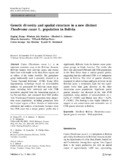| dc.contributor.author | Zhang, Dapeng | es_ES |
| dc.contributor.author | Martínez, Windson J. | es_ES |
| dc.contributor.author | Johnnson, Elizabeth S. | es_ES |
| dc.contributor.author | Somarriba, Eduardo | es_ES |
| dc.contributor.author | Phillips Mora, Wilbert | es_ES |
| dc.contributor.author | Astorga, Carlos | es_ES |
| dc.contributor.author | Mischke, Sue | es_ES |
| dc.contributor.author | Meinhardt, Lyndel W. | es_ES |
| dc.date.accessioned | 2015-11-18T06:02:12Z | |
| dc.date.available | 2015-11-18T06:02:12Z | |
| dc.date.issued | 2015 | es_ES |
| dc.identifier.uri | https://repositorio.catie.ac.cr/handle/11554/7814 | |
| dc.description.abstract | Cacao (Theobroma cacao L.) is an important economic crop in the Bolivian Amazon.
Bolivian farmers both cultivate cacao, and extract fruits from wild stands in the Beni River region and in valleys of the Andes foothills. The germplasm group traditionally used is presently referred to as ‘‘Cacao Nacional Boliviano’’ (CNB). Using DNA
fingerprinting technology based on microsatellite markers, we genotyped 164 Bolivian cacao accessions, including both cultivated and wild CNB accessions sampled from the Amazonian regions of La Paz and Beni, and compared their SSR profiles with 78 reference Forastero accessions from Amazonian
cacao populations, including germplasm from
the Ucayali region of Peru. Results of multivariate ordination and analysis of molecular variance show that CNB cacao has a unique genetic profile that is significantly different from the known cacao germplasm
groups in South America. The results also
show that cultivated CNB and wild CNB populations in the Beni River share a similar genetic profile, suggesting that the cultivated CNB is of indigenous origin in Bolivia. The level of genetic diversity,
measured by allele richness and gene diversity in the Bolivian cacao, is moderately high, but was significantly
lower than gene diversity in the other
Amazonian cacao populations. Significant spatial genetic structure was detected in the wild CNB population, using analysis of autocorrelation (rc = 0.232; P\0.001) and Mantel tests (Rxy = 0.276; P\0.001). This finding is also highly valuable to support in situ conservation and sustainable use of
CNB genetic diversity in Bolivia. | es |
| dc.description.sponsorship | Centro Agronómico Tropical de Investigación y Enseñanza (CATIE)-MAP | es |
| dc.relation.ispartof | Programa Agroambiental Mesoamericano (MAP). Fase I | |
| dc.rights | info:eu-repo/semantics/openAccess | |
| dc.title | Genetic diversity and spatial structure in a new distinct Theobroma cacao L. population in Bolivia | es |
| dc.type | Artículo | es_ES |


